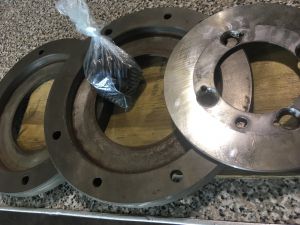- Home
- About Us
- Join/Renew
- Member Benefits
- Member Pages
- Log In
- Help
- Museum Store
Hi, everyone, my engine rebuilder is asking about the correct material to rebuild the harmonic balancer he removed from the front end of the crankshaft. Specifically, the friction material. He says what is there looks more like felt than woven friction material; everything springs, etc, are in good condition. Any advice appreciated.
See photos of the dampener dismantled. Typical dampener I am familiar with, is made of steel/iron parts with rubber vulcanized between. The technician says this appears to be some sort of felt-like friction material.

The tech stated the springs, bolts, metal parts looked good. The friction material: not so well (obviously).

Randy,
Look at this stuff.
I DK, but maybe is is what you need.
Peter
Peter, the material found in the dampener is some sort of fabric or felt material, it is not rubber.
Rolls-Royce at one time used a similarly-constructed dampener. The friction material was a radially-woven cotton duck.
Randy,
I was just giving it a shot based upon modern harmonic balancer types.
You mentioned the rubberized nature of the cloth material and that why I extrapolated to Elastomers, as that is one of the three current types of harmonic balancers.
I just had a bit of time to burn, so I did a bit of research and i couldn’t find information on the material used on the Friction Type of harmonic balancer, but I bet a Speed Shop might know.
Good luck,
Peter
I have a couple of technical papers regarding the Rolls-Royce friction dampener which they used for years. There is discussion and test data of potential substitutes for the original woven cotton duck material. I also found a photo of a cotton duck friction element.
These materials are quite interesting but they do not really answer
My immediate need, which is to restore my Pierce’s dampener to good condition and useful service. Surely someone has answered this question before now (one might reason)?
There is a company that specializes in rebuilding them…….about 700-800 dollars three years ago. The name escapes me.I will post it if I find it.
Thanks, Ed. I found several rebuilders of the rubber vulcanized units but nothing describing this unit.
Ask Bob Dluhy, Ron Blisset, or John Cislak. They should have an answer for you.
In perusing my new Series 80 manual last evening, I noticed the illustration and description of the harmonic damper, including advice that, upon adjusting the compression springs until a tension of 15 pounds applied tangentially at the rim is required to slip the damper. Just like the unit Rolls-Royce used for years.
I did learn this weekend, while studying my 1929-1930 parts lists will illustrations, that the test specification, at least for the Model C engine, is 30 to 40 pounds pull at the rim should cause it to slip.
I have identified a material tested and used by enthusiasts of “Another Motorcar”” and am attempting to obtain some of this material. Will keep you posted.”
